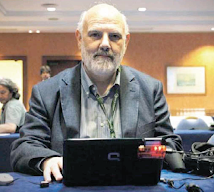Obviously its difficult for a layman like me to decide, but this piece from the NYtimes leaves me with the impression that Intel's titanium project has all the hallmarks of a major technological and commercial disaster. Firstly: decentralisation of processing power. Intel is betting on a mega processor just when things are moving in the opposite direction. Secondly: timing. Intel is moving forward with this at a time when their potential customers are more focused than ever on the bottom line. In the words of one market participant: `If it doesn't save us money we have no interest in it'. Big expensive upgrades just aren't on the horizon right now. Thirdly: the existence of a cheaper - intermediate technology - rival. AMD has an alternative to Itanium that computer makers are seriously considering. So like UMTS it could be a case of the wrong technology in the wrong place at the wrong time. And the curious thing is that as the budget mounts, and the chances of commercial success falls, the project's backers see no other alternative than to keep driving onward and upward. God, this reminds me so much of Concorde.
Itanium, a joint project of Intel and Hewlett-Packard, Silicon Valley's two largest companies, has been in the laboratory for more than a decade. Itanium is designed to excel at a sweeping array of advanced computing tasks, from solving grand scientific challenges to rendering complex graphics to slicing through vast databases. With more than 200 million transistors on each chip, it is designed to process data in big bites — 64 bits, in chipspeak — at blazing speeds.
But Google isn't buying.Eric Schmidt, the computer scientist who is chief executive of Google, told a gathering of chip designers at Stanford last month that the computer world might now be headed in a new direction. In his vision of the future, small and inexpensive processors will act as Lego-style building blocks for a new class of vast data centers, which will increasingly displace the old-style mainframe and server computing of the 1980's and 90's. It turns out, Dr. Schmidt told the audience, that what matters most to the computer designers at Google is not speed but power — low power, because data centers can consume as much electricity as a city.
Intel and Hewlett-Packard chose to start from scratch with a new design for Itanium, requiring programmers to rewrite applications. AMD has taken a more compatible approach. Opteron, which will begin shipping next year, is based on the original Intel-designed X86 instruction set. That means the chip will run all existing software intended for other Intel chips, as well as compatible processors, with only minor alterations. At a technical conference in Silicon Valley in the summer, computer designers were impressed when AMD said the new 64-bit extensions to the existing 32-bit chip required only 2 to 3 percent more silicon. That, they said, is a small price to pay for a 64-bit chip that can also run software applications written for existing 32-bit chips. "We believe customers want an easy migration path to 64 bits," said Marty Seyer, a vice president at AMD.
In the end, Itanium may be most vulnerable to a force that neither Intel nor Hewlett-Packard can control: the economy. Even if Itanium proves a technical success, the most powerful incentive for companies to shift to it lies in the high-performance computing power needed for ambitious new information technology projects. But in the sluggish economy, few companies are increasing capital spending.
Source: NY TIMES
LINK











No comments:
Post a Comment